Prove It To Me - Real Research, Real Data, No BS
Do you get tired of big ideas, exorbitant pitches, inactionable concepts, and empty promises? Cool, me too. I’m Dr. Matt Law, and I’m the host of ”Prove It To Me”. This podcast aims to put theories to the test and bring good research to light by showcasing evidence-based solutions. Guests will be challenged to identify things that actually work, provide research and data to back up their claims, and tell us how to measure and manage real solutions. You’ll hear about a lot of environmental health and occupational safety theories and concepts, but you’ll also learn about general business solutions and maybe even some everyday things that you can apply to your life. We’ll also cover general topics about research, whether it be about measurement tools, statistics, or what differentiates good research from, well, the not so good information out there. ”Prove It To Me” is nerdy. It is serious. It is jovial and fun. It is optionally explicit, but your kids will probably be asleep before we get to any bad stuff anyway. If you’re ready to cut through the BS, maybe learn a little bit about research, and get into the nitty gritty of whether big ideas work or not, you’re in the right place. Have some evidence-based research to share? Send an email to contact@proveitpod.com today! Disclaimer: The views and opinions expressed in this podcast are those of the host and its guests and do not necessarily represent the official position, opinion, or strategies of their employers or companies. Examples of research and data analysis discussed within this podcast are only examples. They should not be utilized in the real world as the only solution available as they are based on very limited, often single-use case, and sometimes dated information. Assumptions made within this discussion about research and data analyses are not necessarily representative of the position of the host, the guests, or their employers or companies. No part of this podcast may be reproduced, stored in a retrieval system, or transmitted in any form or by any means, mechanical, electronic, recording, or otherwise without prior written permission of the creator of the podcast. The presentation of content by the guests does not necessarily constitute an active endorsement of the content by the host.
Episodes

Saturday May 31, 2025
Saturday May 31, 2025
In this #StudyFinds episode of #ProveItPod, Dr. Matt Law attempts to make sense of a meme that claims recent research has found that roasting your friends makes you more loyal and trustworthy. Listen now to find out!
Episode Resources:
Gorman, G., & Jordan, C. H. (2015). “I know you’re kidding”: Relationship closeness enhances positive perceptions of teasing. Personal Relationships, 22(2), 173–187. https://doi.org/10.1111/pere.12071
Johannessen, E. M. V. (2021). Blurred lines: The ambiguity of disparaging humour and slurs in Norwegian high school boys’ friendship groups. Young. https://doi.org/10.1177/11033088211006924
Ledet, B. (2025, March 6). Blair’s social second: Do you insult or roast your friends for fun? FOX 2 Now, Nextar Media Inc. https://fox2now.com/am-show/social-second/blairs-social-second-do-you-insult-or-roast-your-friends-for-fun/
Murti, A. (2020, February 17). Research shows we all should absolutely, relentlessly roast our friends. The Swaddle. https://www.theswaddle.com/why-do-friends-roast-each-other
Platt, M., Malecki, C. K., Luckner, A., Wiemer, K., & Pyun, Y. (2022). You can’t sit with us…just kidding! An investigation into the association between empathy and prosocial teasing. Psychology in the Schools, 59(4), 832–844. https://doi.org/10.1002/pits.22650
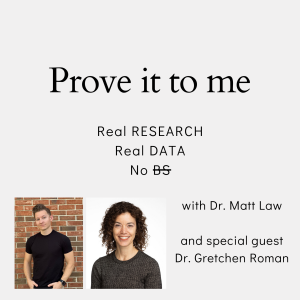
Friday May 02, 2025
Friday May 02, 2025
In this brand new episode of #ProveItPod, Dr. Matt Law talks to Dr. Gretchen Roman about original qualitative research into musculoskeletal disorders and psychosocial hazards among sign language interpreters. Can Total Worker Health® help us better understand the physical and mental health of this population?
Listen now at www.proveitpod.com or wherever you get your podcasts!
About Dr. Roman:
Dr. Roman received her doctoral training at Massachusetts General Hospital, Institute for Health Professions and Arizona State University, College of Health Solutions. She completed her postdoctoral training at the University of Rochester where she investigated the occupational health of sign language interpreters working remotely in response to the COVID-19 pandemic and the impact of a mindful practice intervention on the well-being of medical sign and spoken language interpreters. Dr. Roman is an Assistant Professor in the Department of Family Medicine Research with a dual appointment in the Department of Public Health Sciences at the University of Rochester. Her background includes roles as a physical therapist, orthopaedic clinical specialist, ergonomics consultant, and sign language interpreter. Currently, she is focused on a Mentored Research Scientist Development Award (K01) through the Centers for Disease Control and Prevention’s National Institute of Occupational Safety and Health adapting a previously developed Total Worker Health® program to the context of sign language interpreting.
Episode Resources:
Roman G, Demian C, Love T, Yousefi-Nooraie R. Occupational safety, health, and well-being concerns and solutions for management reported by sign language interpreters: A qualitative study. International Journal of Environmental Research and Public Health. 2024; 21(11):1400. https://doi.org/10.3390/ijerph21111400
Dr. Gretchen Roman – University Profile Page https://www.urmc.rochester.edu/people/112363481-gretchen-a-roman

Friday Apr 18, 2025
Friday Apr 18, 2025
In this #StudyFinds episode of #ProveItPod, Dr. Matt Law digs into a study that suggests married folks are at a higher risk of dementia. Is it true? Listen now to find out!
Episode Resources:
George, J. (2025, March 25). Surprising findings from new research about dementia and marriage - U.S. study could challenge the belief that marriage protects against cognitive decline. MedPage Today. https://www.medpagetoday.com/neurology/dementia/114820
Karakose, S., Luchetti, M., Stephan, Y., Sutin, A. R., & Terracciano, A. (2025, March 20). Marital status and risk of dementia over 18 years: Surprising findings from the National Alzheimer's Coordinating Center. Alzheimer's & Dementia, 21(3). https://doi.org/10.1002/alz.70072

Wednesday Apr 02, 2025
Wednesday Apr 02, 2025
In Part 2 of this #StudyFinds episode of #ProveItPod, Dr. Matt Law continues exploring scare tactics used in workplace safety training and ends up putting his own foot in his mouth. Is this guy even credible? Listen now to find out!
Episode Resources:
Health Communication Capacity Collaborative. (2014). The extended parallel processing model: An HC3 research primer. https://www.healthcommcapacity.org/wp-content/uploads/2014/09/Extended-Parallel-Processing-Model.pdf
Fredrickson, B. L., Cohn, M. A., Coffey, K. A., Pek, J., & Finkel, S. M. (2008). Open hearts build lives: Positive emotions, induced through loving-kindness meditation, build consequential personal resources. Journal of Personality and Social Psychology, 95(5), 1045-1062. https://doi.org/10.1037/a0013262
Lally, P., van Jaarsveld, C. H. M., Potts, H. W. W., & Wardle, J. (2010). How are habits formed: Modelling habit formation in the real world. European Journal of Social Psychology, 40(6), 998–1009. https://doi.org/10.1002/ejsp.674
Law, M. (2020). Four reasons OSH professionals must be better salespeople. Professional Safety, 65(2), 28-31.
Li, S.-C. S., Lu, P.-C., & Chen, S.-C. (2020). Emotions in fear appeals: Examining college students’ attitudes and behavioural intentions towards colorectal cancer prevention in Taiwan. Health Education Journal, 79(5), 569–582. https://doi.org/10.1177/0017896919891749
Liang, S., Raymond Rui, J., & Xu, P. (2022). Risk or Efficacy? How risk perception and efficacy beliefs predicted using hearing protection devices among different groups of Chinese workers. Safety Science, 154, 105858-. https://doi.org/10.1016/j.ssci.2022.105858
Page-Bottorff, T. (2016). The habit of safety: Forming, changing & reinforcing key behaviors. Professional Safety, 61(2), 42-43.
Trope, Y., & Liberman, N. (2010). Construal-Level Theory of Psychological Distance. Psychological Review, 117(2), 440–463. https://doi.org/10.1037/a0018963
Worthington, A. K. (2023). 5.1: Fear appeals – The extended parallel process model. In A. K. Worthington, Persuasion theory in action: An open educational resource (pp. 5.1.1-5.1.5). https://socialsci.libretexts.org/@go/page/179347
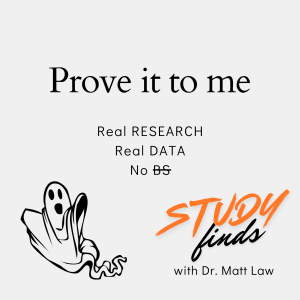
Friday Mar 07, 2025
Friday Mar 07, 2025
In this new #StudyFinds episode of #ProveItPod, Dr. Matt Law does a rapid-fire deep dive into scare tactics used for workplace safety training. Do they work? Listen now to find out!
Episode Resources:
Brookes, G., & Harvey, K. (2015). Peddling a semiotics of fear: a critical examination of scare tactics and commercial strategies in public health promotion. Social Semiotics, 25(1), 57–80. https://doi.org/10.1080/10350330.2014.988920
Carey, R. N., McDermott, D. T., & Sarma, K. M. (2013). The impact of threat appeals on fear arousal and driver behavior: A meta-analysis of experimental research 1990-2011. PloS One, 8(5), e62821–e62821. https://doi.org/10.1371/journal.pone.0062821
Health Communication Capacity Collaborative. (2014). The extended parallel processing model: An HC3 research primer. https://www.healthcommcapacity.org/wp-content/uploads/2014/09/Extended-Parallel-Processing-Model.pdf
Koehler, M., Brockamp, T., Bamberg, S., & Gehlert, T. (2022). Change of risk behaviour in young people – the effectiveness of the trauma prevention programme P.A.R.T.Y. considering the effect of fear appeals and cognitive processes. BMC Public Health, 22(1), 595–595. https://doi.org/10.1186/s12889-022-12918-2
Türkel, S., Misci Kip, S., & Yasdıman, F. E. (2020). Use of fear appeal in work safety messages: An experimental study. Türkiye Iletişim Araştırmaları Dergisi, 36, 253–267. https://doi.org/10.17829/turcom.842695
Worthington, A. K. (2023). 5.1: Fear appeals – The extended parallel process model. In A. K. Worthington, Persuasion theory in action: An open educational resource (pp. 5.1.1-5.1.5). https://socialsci.libretexts.org/@go/page/179347

Friday Feb 21, 2025
Friday Feb 21, 2025
In this brand new episode of #ProveItPod, Dr. Matt Law talks to Dr. Mani Berenji about mental health in the workplace, the research behind addressing mental health, the resources available to employers, and important discussions about messaging and the purpose of Total Worker Health®
Listen now at www.proveitpod.com or wherever you get your podcasts!
About Dr. Berenji:
Dr. Berenji is a double board certified physician specializing in Occupational and Environmental Medicine as well as Preventive Medicine. She is currently Chief of Occupational Health at VA Long Beach Healthcare System. She also leads the Environmental Health Clinic at VA Long Beach Healthcare System, conducting exposure assessments for veterans (including Agent Orange, Gulf War, and Open Burn Pit registry exams). She is Associate Clinical Professor in the Department of Occupational and Environmental Medicine at UC Irvine School of Medicine as well as Associate Clinical Professor in the Department of Environmental and Occupational Health at the Wen School of Public Health. She is Lead of Academic and Community Partnerships with the University of California Center for Climate, Health and Equity, where she is spearheading efforts to enhance academic and industry partnerships; evaluating new methodologies to enhance emergency preparedness surrounding climate-related events; working with community leaders on identifying practical climate solutions; and developing climate curricula for medical students and residents. She is currently pursuing board eligibility in Clinical Informatics through the American Board of Preventive Medicine’s Practice Pathway. She is Chair of the Health Informatics as well as the Environmental Health section of ACOEM and continues to lead the ACOEM Presidential Task Force on Digital Transformation through a Planetary Health Lens. She is also a certified medico- legal evaluator and qualified medical examiner in the state of California.
Episode Resources:
Mental Health at Work - World Health Organization
Workplace Mental Health - American Psychiatric Association
One Mind at Work
Mental Health at Work Index
Five Essentials for Workplace Mental Health and Well-Being - Office of the Surgeon General
5 Strategies for Improving Mental Health at Work - Harvard Business Review
Mental Health in the Workplace - Washington State Department of Labor & Industries

Friday Feb 07, 2025
Friday Feb 07, 2025
In this new #StudyFinds episode of #ProveItPod, Dr. Matt Law has a meltdown over the dirty C-word and proceeds to burn all the bridges with malice and forethought. He didn't even hit the alarm. Grab your fire extinguisher, and listen now!
Episode Resources:
Study explores complacency during workplace fire evacuations. (2025). Professional Safety, 70(1), 13.
Accessible at www.assp.org with a valid membership.
Occupant complacency in workplace fire evacuations
Gold, D., Thomas, D., Vincer, N., & Pitkin, M. (2024). Occupant complacency in workplace fire evacuations. Humanities & Social Sciences Communications, 11(1), 1134–15. https://doi.org/10.1057/s41599-024-03665-3
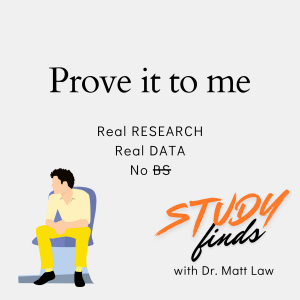
Friday Jan 17, 2025
Friday Jan 17, 2025
In this new #StudyFinds episode of #ProveItPod, Dr. Matt Law has a short but sill unreasonable tangent about research dissemination followed by an investigation into a real workplace hazard. Like seriously. It's actually about #safety this time. And #health. Are you sitting down? Might actually be time to stop that.
Episode Resources:
Study asks: How much sedentary time is too much?
Accelerometer-Measured Sedentary Behavior and Risk of Future Cardiovascular Disease
Ajufo, E., Kany, S., Rämö, J. T., Churchill, T. W., Guseh, J. S., Aragam, K. G., Ellinor, P. T., & Khurshid, S. (2024). Accelerometer-measured sedentary behavior and risk of future cardiovascular disease. Journal of the American College of Cardiology. https://doi.org/10.1016/j.jacc.2024.10.065
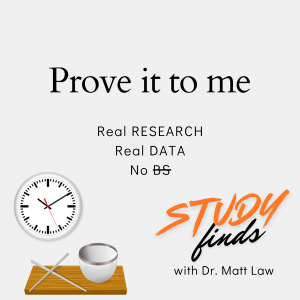
Friday Dec 20, 2024
Friday Dec 20, 2024
In this new "Study Finds" episode, Dr. Matt Law looks behind the headlines once again to figure out if late eaters are doomed in life. Will eating after 5pm kill you? Listen to find out!
Episode Resources:
Concerning study finds 'serious consequences for health' for people who eat after 5pm - Daily Mail
Eating After 5 PM Could Be Damaging Your Metabolic and Heart Health - SciTechDaily
Late eating is associated with poor glucose tolerance, independent of body weight, fat mass, energy intake and diet composition in prediabetes or early onset type 2 diabetes - Nutrition & Diabetes
TREAT to Improve Cardiometabolic Health (NY-TREAT) - ClinicalTrials.gov
Díaz-Rizzolo, D.A., Santos Baez, L.S., Popp, C.J., Borhan, R., Sordi-Guth, A., Manoogian, E.N.C., Panda, S., Cheng, B., & Laferrère, B. Late eating is associated with poor glucose tolerance, independent of body weight, fat mass, energy intake and diet composition in prediabetes or early onset type 2 diabetes. Nutr. Diabetes 14, 90 (2024). https://doi.org/10.1038/s41387-024-00347-6
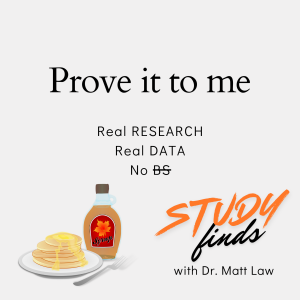
Friday Dec 06, 2024
Friday Dec 06, 2024
In this new "Study Finds" Episode, Dr. Matt Law digs into the truth behind the headlines claiming that maple syrup can prevent heart disease. Is it true? You'll have to listen to find out.
Episode Resources:
Morning Ag Clips - Why Substitute Sugar With Maple Syrup?
Study Abstract
Morissette, A., Agrinier, A.-L., Gignac, T., Ramadan, L., Diop, K., Marois, J., Varin, T. V., Pilon, G., Simard, S., Larose, É., Gagnon, C., Arsenault, B. J., Després, J.-P., Carreau, A.-M., Vohl, M.-C., & Marette, A. (2024). Substituting Refined Sugars With Maple Syrup Decreases Key Cardiometabolic Risk Factors in Individuals With Mild Metabolic Alterations: A Randomized, Double-Blind, Controlled Crossover Trial. The Journal of Nutrition, 154(10), 2963–2975. https://doi.org/10.1016/j.tjnut.2024.08.014









